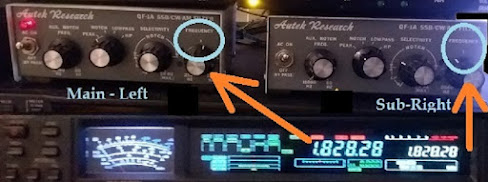I recently published a compendium Blog on the Stereo-Audio concept. What began as Stereo-Cw quickly evolved into Stereo-RTTY and eventually Stereo-Ssb. The Stereo-Ssb world is quite unique. The Blogs written on this sub-subject include:
- [X] - How Stereo-Cw becomes Stereo-Ssb (Mar/2021)
- [X] - Stereo Ssb: It's STILL Easier than you Think (Oct 2022)
- [X] - Stereo-SSB: Turns out There's More To It (Dec 2022)
- [X] - Stereo-Ssb Revisited (Yet Again) (Mar 2023)
- [X] - For WQ6X: Stereo-SSB creates Quite a Saucy sensation
for a Sensational Sweepstakes (Nov 2023)
For the 2024 ARRL Dx Ssb contest, complicated Space-WX conditions contributed to experimenting with using Stereo-Ssb to improve the signal-to-noise ratio, transforming jumbled speech patterns into something more intelligible.
Running remote to the WA6TQT and KN6NBT stations means I am using an Elecraft K3/0-Mini to access the fully configured K3 radios on the remote end of the radio connection. While the dynamic range specifications of the K3 may be numerically superior to other transceivers, the Shift/Width controls, the DSP DNR and auto-notch facilities (in my opinion) leave a LoT to be desired.
From my operating experience the FT-2000's Shift/Width manual-notch/Contour controls are far more effective that the K3 facilities, and, are way-more ergonomically pleasing - if it ain't pleasing, we don't use it. Back-ending DSP reception by way of analog Stereo-Ssb stereo techniques make up for the perceived audio inadequacies of the Elecraft design.
Using the QF-1A Frequency knobs to effectively alter the "shape" of the audio passband helps
eliminate the offending signal components, while peaking the more-desirable voice characteristics.
With the individual Frequency knobs, we can actually "move" (i.e. "emphasize") a component of the voice, shifting its significance, which enhances our experience of it all.
eliminate the offending signal components, while peaking the more-desirable voice characteristics.
With the individual Frequency knobs, we can actually "move" (i.e. "emphasize") a component of the voice, shifting its significance, which enhances our experience of it all.
Because I sometimes run a frequency with one VFO and S&P using the other, having adjustable filters (the QF-1A's) in-line makes what was once confusing cacophony much less cacophonic.
It was quickly realized that L -- R ear settings which work for one operating frequency and specific voice characteristics don't work for others. Another realization is that while some audio frequencies are peaked by the process, Stereo-Ssb is largely a SUBTRACTIVE process, eliminating things that we don't like, which often induces its own artifact components (as the K3 does).
In WQ6X stereo-audio configurations, to overcome amplitude-drop when cascading different audio filters I have been experimenting with various stereo audio amplifier boards and commercial audio amplifier units following the last filter in each audio line to overcome those amplitude losses.
This may also be an appropriate place to insert a stereo audio equalizer - just prior to the final amplification, reducing any audio filter-induced artifact(s).
This may also be an appropriate place to insert a stereo audio equalizer - just prior to the final amplification, reducing any audio filter-induced artifact(s).
For a more visual indication of the Stereo-Ssb effects, an oscilloscope or audio spectrum analyzer can provide additional insight (feedback) to our overall aural-experience. For the March 2024 ARRL Dx Ssb contest, the Stereo-Ssb filtering actually provided more effective noise-reduction (w/virtually
no artifact) than the K3's built-in DSP-NR facility.
no artifact) than the K3's built-in DSP-NR facility.
Have YOU ever experimented w/Stereo-Ssb in amateur radio?
If NoT, whut are you WAITing for?
If so, what kind of results DiD You achieve?


No comments:
Post a Comment